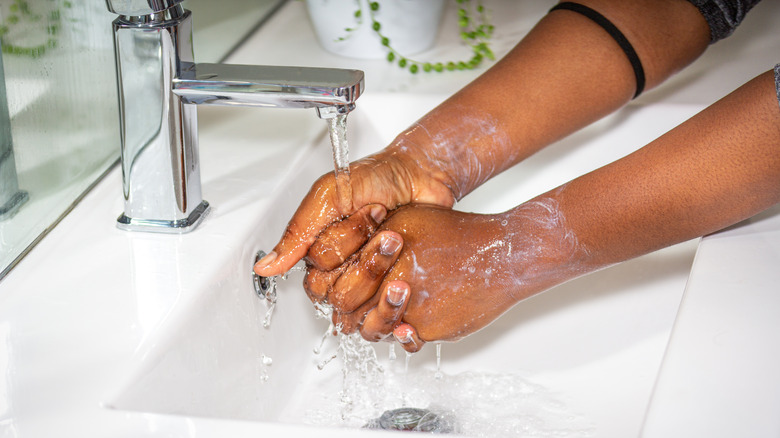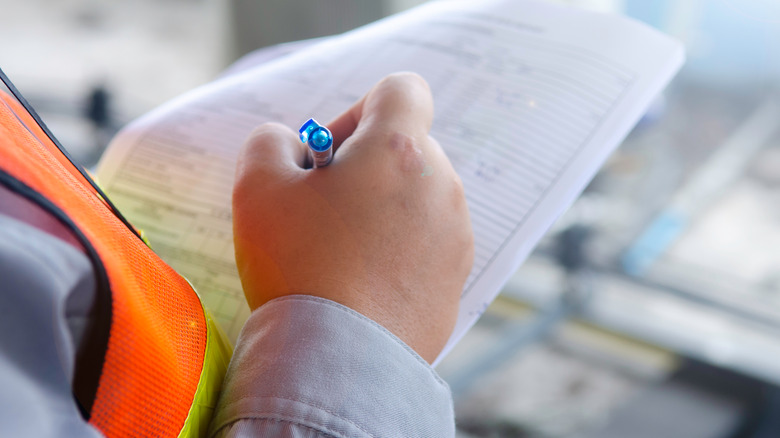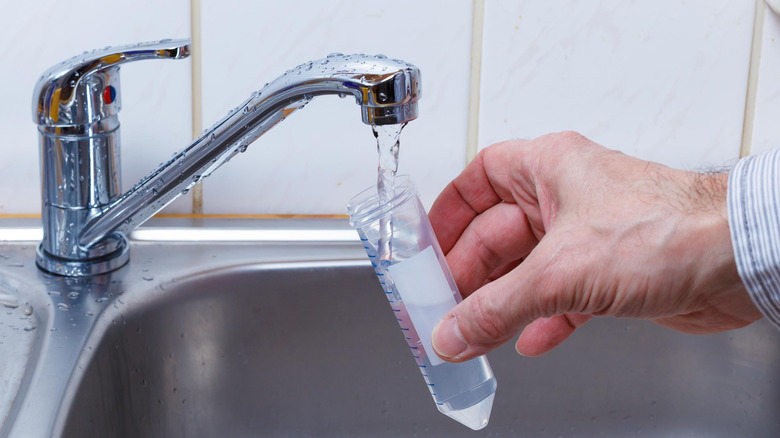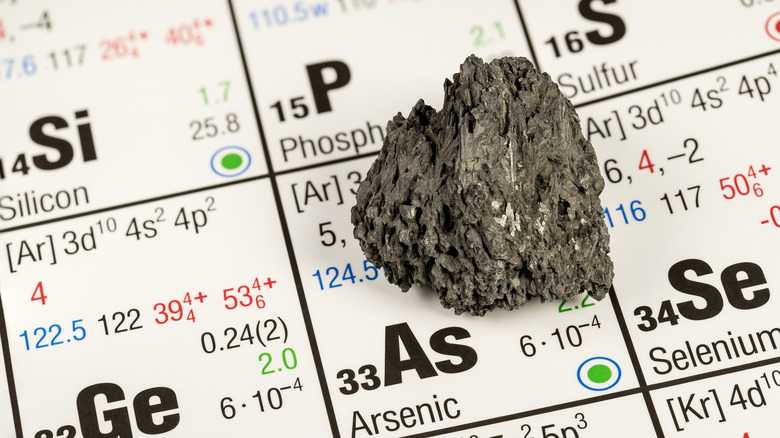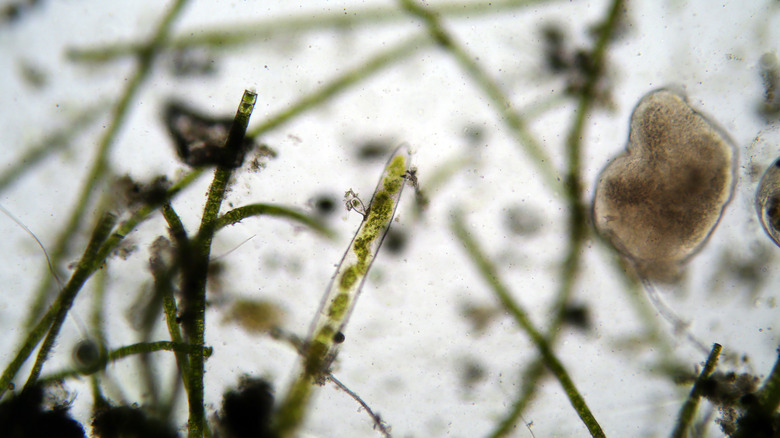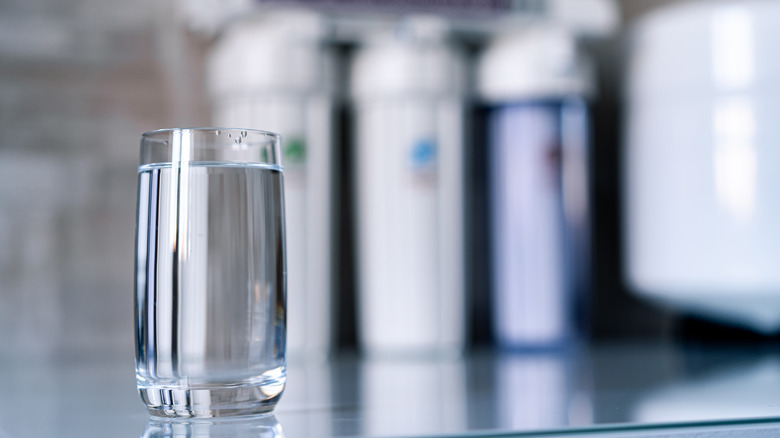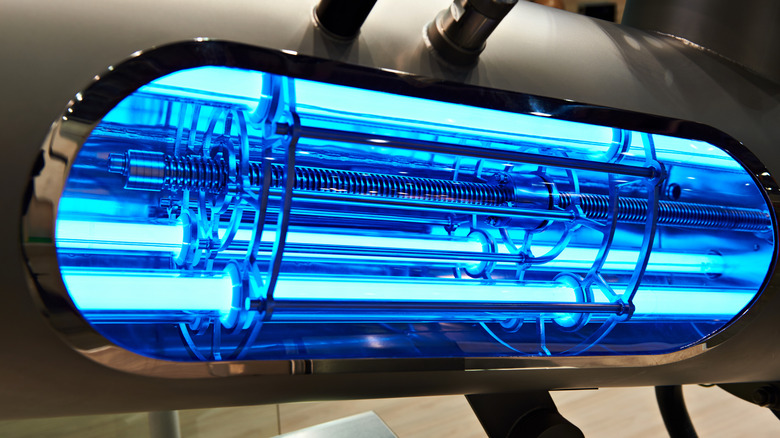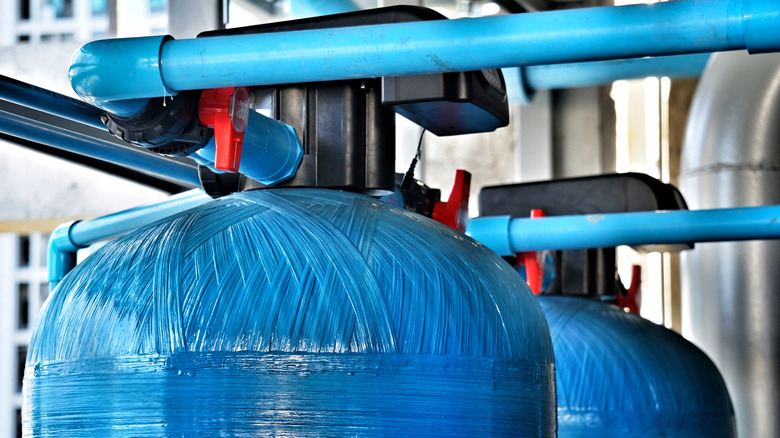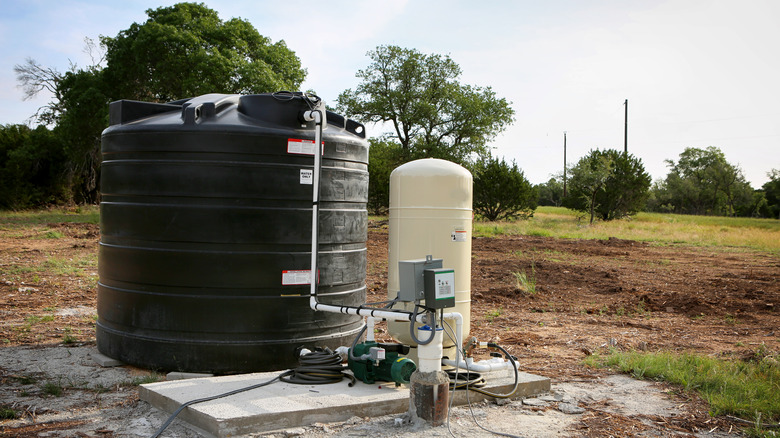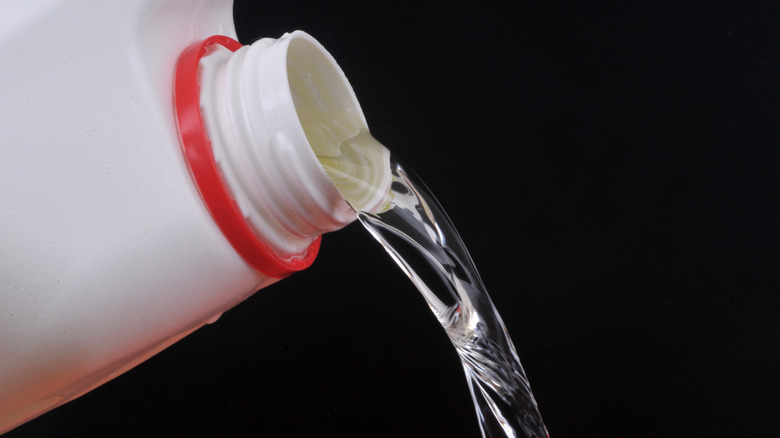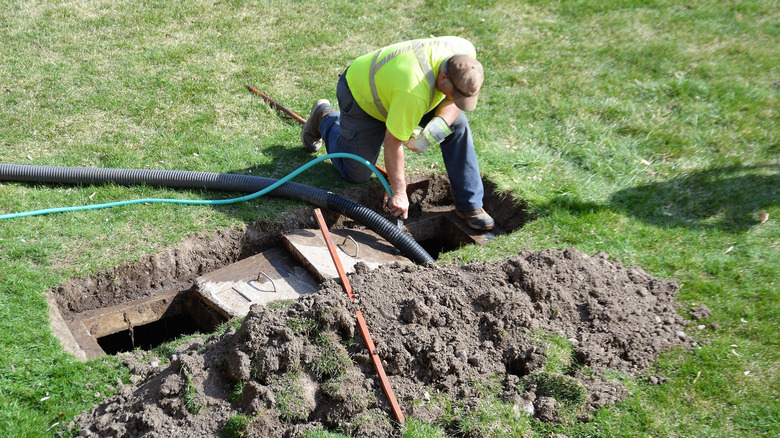What You Should Know About Well Water Before Buying A House
From your morning shower to your Sunday afternoon bath, water is vital to our lives. From the water that we drink to the water in our washing machines and ice cube makers, having a clean, reliable water source can be a "make it or break it" decision when purchasing a home. It makes sense. We are made from about 60% water, the United States Geological Survey reports. Armed with a bit of knowledge, you can find out all the important things to know when buying a house using well water.
Pumping water out of the ground to use to irrigate your garden, fill your pool or spa, or make your cup of coffee does come with a learning curve and some challenges. Before you buy, there are a lot of questions you need to get answered. Once you learn all about the property's well situation — from the available groundwater to the well's mechanisms to the required upkeep — you'll have all the facts so you can make the best decision for you and your family. We've identified strategies for unearthing (see what we did there?) everything you need to know about well water before buying a home with one.
1. Start with a well inspection
Not only should a well be inspected every year, but you also need a well inspection before purchasing any property with well water. Well inspectors are certified by InterNachi after passing a comprehensive course. To find a well inspector and get a ballpark figure of what a well inspection costs, use Thumbtack as a resource. Ask your real estate agent or local health department for a personal recommendation. Yes, a home inspector may give your well and pump a cursory look, but according to Clever Real Estate, a visual inspection is just that. Just because your plumbing looks fine does not mean the well is operating at the appropriate levels. Rather than relying on the home inspector, employ a professional well inspector who will take an in-depth look. Additionally, a proper well inspection is usually needed to satisfy both loan and real estate requirements.
When you think about it, your well is your house's personal water utility, so it comes with a set of rules and responsibilities. You can rely on your well inspector to know the local, city, county, and regional requirements for well water. A reputable inspector will ensure all the well components, including the pump, pressure tank, and pipes, are functioning correctly. In addition to hiring your own inspector, it's also a good idea to ask the current property owner for the previous well documentation.
2. Get your water tested
Knowing the parts of your well are in good working order, now it's time to check the water. Sometimes basic tests are included with the inspection, but if not, many agencies can assist you in getting your well water checked. These standard tests range in price, but should cost between $25 and $400, depending on how many of them you order, says Clean WaterTesting. Testing water clarity is inexpensive and should cost around $15 (via Community Science Institute). Like pool water, well water is tested for pH, which costs about $10, and alkalinity, which clocks in around $20. The majority of well water is hard, so you may want to find out which particular minerals are in your supply (via Wellowner). Also, consider adding a test for man-made and harmful Volatile Organic Compounds (VOCs), which costs about $113.
Once you test the water quality on your potential property, you might want to test if the well produces enough water. A flow test tells you the speed your water is extracted from the ground. The average flow is between six and 12 gallons per minute. Costing about $255, this test lets you know if your well can meet your household's water needs (via Thompson Pump and Irrigation). If your flow is low, you will need to consider upgrading your pump or adding a holding tank (via Bruce MacKay Pump & Well Service).
3. Learn about possible pollutants
If you can remember back to primary school, where we learned about the water cycle, you'll remember that when water evaporates into the air, it creates water vapor. Then, the vapor rises into the atmosphere, forms clouds, makes the clouds heavy, and voila — rain and snow, per the National Oceanic and Atmospheric Administration. And sometimes, when that water falls, it carries man-made chemicals with it. Groundwater can contain harmful pollutants that can seep into a well's water supply. From household paints, pesticides, and disinfectants to commercially used inks, dyes, and petroleum products, organic chemicals can do serious injury to your internal organs and systems (via U.S. Environmental Protection Agency (EPA)). Radioactive contamination, often from mining and its runoff, can get in your well water, too.
Another set of pollutants are nitrates and nitrites, and tests run $35 (via Community Science Institute). These impurities are found in human and animal waste and fertilizers, and can seep into your water supply if found in the ground nearby. When you ingest them, nitrates are processed into nitrites and clog the oxygen-carrying capacity of your red blood cells. When investing in a house with a well, be prepared to test the water for all of these harmful pollutants before making an offer.
4. Find out about naturally occurring contaminants
As water trickles through cracks in the earth, it picks up elements embedded in the rock and dirt. Because of this, fluoride can often be found in water. Yes, fluoride is a popular toothpaste and mouthwash additive. Yes, it's also added to many municipal water supplies, per the Centers for Disease Control and Prevention (CDC). But too much fluoride is harmful. If kids get too much, it can damage their teeth. In adults, extra fluoride can lead to bone and joint pain and tenderness (via EPA).
We can all appreciate the problems caused by heavy metals. Common elements include arsenic, copper, lead, mercury, and nickel. They leech into the groundwater from both naturally occurring sources and manufacturing runoff. Plumbing made from copper and lead can also get these heavy metals into your home. These toxins can cause damage to your liver, kidneys, and blood. Testing for these impurities will run you $30 per metal (via Community Science Institute).
5. Look for little life forms
If you've ever put a drop of pond water on a glass slide and looked at that clear-looking drop under a microscope, then you've seen some of the microorganisms that are commonly found in water. Bacteria, parasites, and tiny viruses are common culprits causing gastrointestinal troubles and infections, according to the EPA. While most of these little life forms are harmless, others can make you a little sick, and some can kill you. Simple bacteria tests cost about $45 (via Community Science Institute).
A parasite causes waterborne bacterial diseases like cholera, dysentery, and scary-sounding cryptosporidiosis. The National Center for Biotechnical Information (NCBI) reports pathogens get in the water through human and animal excrement. Nobody wants that. Hepatitis A and E. coli are also waterborne. In addition to trying to catch harmful bacteria and parasites in your water, a well inspector will also test the total coliforms, which are microbes found everywhere from soil to digestive tracts to plants (via CDC.) Interestingly, when testing for total coliforms, the technician won't test for a specific microorganism, but will look at the total number of living things in the well water. If there are a lot of microbes in there, then there is a high likelihood that some of them are harmful.
6. Find out about your parcel
When investigating the state of a property's well system, there's no better way to evaluate the situation than to walk the property line. Use this time to locate the septic tank, system, and leach field, and ensure the well doesn't have sediment buildup or is placed in a hazardous location, advises Bob Vila.
Check to see if there are old wells on your homesite (via Beverly-Hanks Realtors). Also, look around at your neighbors and your landscape. Are there farms? If there are agricultural operations, then check for run-off and seepage-related issues. Are there businesses and roads? Petroleum and anything that comes out of a tailpipe can possibly contaminate your well water. Do your surrounding neighbors have wells? Ask them about their wells and well water. Also, ask if they are on the public sewer system or if they have septic systems. If they have septic systems, are their wells located at a safe distance? Knowing all of this will help you decide if the property's well system is safe and optimal.
7. Assess your water use
A well can only supply so much water, so it's paramount to know how much water your household uses. While a long hot bath is relaxing and soothing, it can also use 50 gallons of water, reports Take Care of Texas. A 10-minute shower usually uses 25 gallons of water, and a toilet utilizes 33 gallons a day (via Water Footprint Calculator). Because of this, and average household uses between 88 to 200 gallons of water per day.
This costs the average family about $1,000 a year. Of course, that amount is higher in drier areas and when irrigating garden areas (via EPA). Since well water is free and upkeep is less than the average water bill, using well water is less expensive (via Insurify). But you need to know how much water your well provides, and if that's compatible with how much water you need. If you're filling and maintaining a pool, hot tub, pond, or other water feature, there's an easy way to calculate how much water you need. Swimming Pool has a calculator and reports that each cubic foot of water comprises 7.5 gallons of water. If you know the dimensions — length, width, and depth — of your landscape's water component, it's a snap to see how much water it holds.
8. Investigate different types of water filtration
There are 10 common types of water filtration systems, and the type of filters you need is dictated by the water in your well, per BrizFeel. That's because each has specific contaminant removing qualities. Water softening resin bead filters – instead of salt-based softeners – start at $1,000, and replacement runs a few hundred dollars (via FilterSmart). Resin filters create mineral-breaking (commonly calcium, iron, and magnesium) ions responsible for hard water (via Guardian Water Service). Carbon filters not only neutralize impurities, but don't allow pesticides, bacteria, and metals into your water (via SpringWell Water Filtration Systems). This is the least expensive type of filtration, and runs between $45 and $1260 (via Home Depot).
However, reverse osmosis filtering is the best known. According to Bob Vila, these filters use pressure to force water through a semipermeable membrane. The membrane filters out both fluoride and heavy metals, and the clean water comes out the other side of the salty filter. Then there are the water ionizers, which cost from $3,500 to $5,600, with replacement filters running $120 a year to maintain (via Quality Water Treatment). They use electricity to charge the water, increasing its alkalinity but removing heavy metals and pesticides. Once the impurities in your water are identified, make sure you choose appropriate filtration.
9. Implement light ray filters to remove unwanted life forms
A water purification system requires professional consultation. Most systems are a combination of filters designed to treat the household's well water. Because water absorbs a little of what it comes in contact with, sometimes bacteria can seep into the water supply. When the well test reveals the presence of bacteria in the water, there are two filtering options to install: ultraviolet and infrared. At opposite ends of the electromagnetic spectrum, these rays destroy microorganisms. Often made from ceramics, infrared filters send high-frequency waves through the water. These waves break apart the water molecules, releasing the impurities, which then stick to the filter. Additionally, they keep bacteria from growing, and make the water taste and smell fresh (via Osmio Water).
Ultraviolet (UV) filters, cousin of the infrared filter, are the best for removing microorganisms in the water, but do not remove chemicals or heavy metals (via Bob Vila). These lamps apply UV light to the water and destroy 99.99% of pathogens (via ESP Water Products).
10. Consider a water softener
Adding a water softener to a well water filtration system is a great way to remove the minerals that create hard water. Hard water is made when naturally occurring minerals enter the water supply, and it's one of the most common issues with well water. Fresh Water Systems reports 85% of families have hard well water. The minerality of the water puts spots on your glassware, scales on your faucets and showerheads, and is responsible for that ring around the bathtub. If hard water gunks up things you can see, imagine the damage it's doing to your water heater, dishwasher pipes, and washing machine parts. Plus, who wants to spend more time cleaning fixtures and rewashing dishes?
Water softeners use ions to pull minerals like calcium and magnesium from your water, which allows your family to enjoy softer water. The average system costs $1,500, but depending on your home and property size, it could set you back $6,000 (via (via Bob Vila). Companies like Culligan offer water softener rentals and maintenance plans, so pouring big, awkward bags of salt in the tank could be a thing of the past.
11. Consider all the costs of a well
If your property does not have an existing well, and you're considering drilling one, it is prudent to talk to a surveyor about where to locate your well. In addition to the permits, drilling a well costs an average of $5,500, with a range of $1,500 to $12,000, according to Home Advisor. While wells have a lifespan of about 50 years, pressure tanks, which are essential to pump water into the home, last about 10 years and cost about $500 to replace (via Beverly-Hanks Realtors).
If installing a whole house water system is too costly, many filtering devices are available for individual faucets. Remember that all the filters — chemical, mechanical, and biological — also need regular replacing. When your household water comes from a public utility, it keeps running if the electricity goes out. However, if you operate a well and the power ceases, so does your ability to extract water and get it to the home. Many well owners also invest in a generator to use in case of an extended power outage (via Oakville Pump Service).
12. Keep your well water clean
Keeping bacteria and harmful microorganisms out of your water is vital. Thankfully, there's a convenient, inexpensive way to rid yourself of them: plain bleach. Every inch of your water system needs to be regularly disinfected. Shock chlorination works by adding plain bleach to most of your water equipment. Make sure to disconnect carbon filters and read the instructions for the other filters to keep them from being damaged by the bleach, says New Mexico State University. Try using bleach without any fragrances or extra additives.
When cleaning the well with bleach, prepare to take the system offline for at least eight hours, but 24 hours is ideal. That means there can be no running water, washing, drinking, or flushing while disinfecting the water components. When the process is complete, flush the chlorine from your system by running a hose to an area where the bleached water won't hurt anything to purge the system.
13. Keep an eye on your water
Keep an eye and a nose on your well water. Changes in your water in color, taste, aroma, or even texture could indicate an issue in your water system. If you cannot identify the problem, schedule an inspection. Although most changes aren't bad for your health, they should be evaluated by a professional. According to Rocket Mortgage, a rotten egg smell in your water can indicate bacteria present, and an orangish-brown color means too much iron.
Although the EPA doesn't regulate private water supplies, the CDC suggests steps every private well owner should do to keep their water safe and tasty. The agency recommends making a visual inspection of your equipment and testing for total coliform bacteria, nitrates, total dissolved solids, and pH once a year. It's also a good idea to perform these tests if there are changes to your water system or any changes on your property that could affect groundwater. When it comes to the quality of the water your family uses every day, spotting and solving little problems can save you valuable money and time.
14. You need to keep your well and septic systems separated
The well water used for drinking and bathing often comes from right under your home's feet. While this might seem like common knowledge and common sense, keeping the septic and well systems at least 100 feet apart is necessary. Since the lifespan of an average well is 30 to 50 years, some older and often larger properties may have had multiple dwellings and wells, per Beverly-Hanks Realtors. The complete septic system should be located and inspected before the purchase of any site using well water.
When rain falls or snow melts, it runs through substances in the ground. Harmful microorganisms, parasites, viruses, and bacteria from a nearby septic system can trickle down into your well water (via EPA). Waste leakage can reach a water source and result in microorganisms being present in water wells, which is why it's important to know how close septic systems and wells are to one another before purchasing the property (via Bob Vila).
